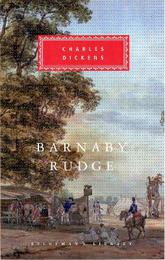
|
Barnaby Rudge
Hardback
Main Details
Description
The first of Dickens's historical novels, Barnaby Rudge, written in 1841, is set at the time of the anti-Catholic riots of 1780, with the real Lord George Gordon, leader of the riots, appearing in the book. The characters are caught up in the resulting mob lawlessness which climaxes in the destruction of Newgate prison, an actual event brought to life in the novel. The plot turns on the relationship between Catholic Emma and Protestant Edward, further complicated by the earlier murder of Reuben Haredale, supposedly by Barnaby though actually by his evil father; but the real focus of the book, as so often in Dickens, is London itself. This is a nightmarishly vivid picture ofa capital city's subterranean life. In A Tale of Two CitiesDickens was to recapture his vision of the mob in all its moods, but he never surpassed the sense of pulsating energy and dangerevoked in thecrowd scenes of Barnaby Rudge. Nor did he often rival the touching relationship between Barnaby and his pet raven, Grip, who embodies the mystical powerof innocence. Although Barnaby Rudge is one of Dickens's lesser known novels, the bond between boy and bird makes it one of his most touching.
Author Biography
Charles Dickens (Author) Charles Dickens was born in Hampshire on February 7, 1812. His father was a clerk in the navy pay office, who was well paid but often ended up in financial troubles. When Dickens was twelve years old he was send to work in a shoe polish factory because his family had been taken to the debtors' prison. Fagin is named after a boy Dickens disliked at the factory. His career as a writer of fiction started in 1833 when his short stories and essays began to appear in periodicals. The Pickwick Papers, his first commercial success, was published in 1836. In the same year he married the daughter of his friend George Hogarth, Catherine Hogarth. The serialisation of Oliver Twist began in 1837 while The Pickwick Papers was still running. Many other novels followed and The Old Curiosity Shop brought Dickens international fame and he became a celebrity in America as well as Britain. He separated from his wife in 1858. Charles Dickens died on 9 June 1870, leaving his last novel, The Mystery of Edwin Drood, unfinished. He is buried in Westminster Abbey. Peter Ackroyd (Introducer) Peter Ackroyd is an award-winning historian, biographer, novelist, poet and broadcaster. He is the author of the acclaimed non-fiction bestsellers London- The Biography, Thames- Sacred River and London Under; biographies of figures including Charles Dickens, William Blake, Charlie Chaplin and Alfred Hitchcock; and a multi-volume history of England. He has won the Whitbread Biography Award, the Royal Society of Literature's William Heinemann Award, the James Tait Black Memorial Prize, the Guardian Fiction Prize, the Somerset Maugham Award and the South Bank Prize for Literature. He holds a CBE for services to literature.
|